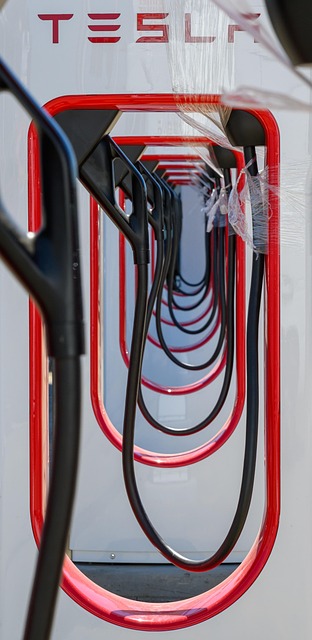Understanding EV charging needs in apartment complexes is crucial for sustainability. Select EV Charging Stations based on resident vehicles, preferences, and space (Level 1, 2 or wireless). Consider regulations, payment options, and local infrastructure. Smart charging solutions enhance satisfaction, efficiency, and safety. Evaluate costs, installation, and maintenance for strategic placement. Advanced wireless tech offers seamless, aesthetic experiences. Implement for optimal resident satisfaction and sustainable living.
In today’s electric vehicle (EV) revolution, equipping apartment complexes with efficient EV charging stations is no longer an option but a necessity. This comprehensive guide navigates the process of selecting suitable EV charging stations for apartments, addressing crucial aspects like understanding resident needs, comparing station types, and integrating smart technologies. By evaluating location, installation, cost, and resident experience, property managers can enhance their complex’s sustainability and convenience.
- Understanding EV Charging Needs for Apartments
- Types of EV Charging Stations: A Comparison
- Evaluating Location and Installation Considerations
- Integrating Smart Charging Solutions
- Cost Analysis: Budgeting for EV Infrastructure
- Enhancing Resident Experience with Efficient Charging
Understanding EV Charging Needs for Apartments

Understanding the electric vehicle (EV) charging needs of apartment complexes is a crucial step in transitioning to a greener future. With an increasing number of EVs on the road, providing convenient and accessible charging solutions for residents becomes essential. Apartment complexes offer unique challenges and opportunities when it comes to EV charging infrastructure.
The selection of EV charging stations should consider factors such as the number of resident vehicles, their charging preferences, and available space. While traditional plug-in chargers are common, some apartment communities are exploring innovative options like wireless EV charging technology, especially for shared or common areas. This technology not only simplifies the installation process but also reduces the need for visible infrastructure, ensuring a more aesthetically pleasing environment. By evaluating these factors, complexes can ensure they offer efficient and practical EV charging solutions to meet the diverse needs of their residents, fostering a sustainable living experience comparable to modern workplaces that already incorporate ev charging stations at convenient locations.
Types of EV Charging Stations: A Comparison

When considering EV charging stations for an apartment complex, understanding the available types is essential. There are three main categories to choose from: Level 1 (or standard), Level 2 (or advanced), and wireless EV charging technology. Level 1 chargers are the most basic and use a standard household outlet, making them the least expensive option but also the slowest charger. These are ideal for light usage or backup situations. Level 2 chargers, on the other hand, require dedicated electrical installations and offer faster charging times, making them suitable for everyday use in apartments.
Wireless EV charging technology represents a newer, more innovative approach. This method allows residents to charge their vehicles without physical connections, eliminating the need for complex installation processes. However, it’s currently the most expensive option and may not be as widely available. Considering local ev charging regulations and policies is also crucial when selecting a station type. Additionally, some complexes offer EV charging stations with payment options, providing residents with flexible and convenient ways to pay for their electricity usage based on individual consumption.
Evaluating Location and Installation Considerations

When evaluating locations and installation considerations for EV (electric vehicle) charging stations in apartment complexes, several key factors come into play. First, select EV charging stations that align with your complex’s needs. This involves assessing the number of residents owning EVs, their charging habits, and the available space. Public EV charging station pricing can vary widely, so budgeting is essential to ensure you choose a solution that fits within your financial framework without compromising quality or accessibility for residents.
The installation process itself requires careful planning. Consider the home EV charger installation cost as an initial investment, which may include electrical upgrades and infrastructure adjustments. It’s crucial to engage with professionals who understand both the technical aspects of EV charging and apartment complex management to ensure a seamless integration that enhances resident satisfaction while maintaining the safety and efficiency of your building’s systems.
Integrating Smart Charging Solutions

Integrating smart charging solutions into apartment complexes is a strategic move that enhances resident satisfaction while promoting sustainable living. When selecting EV charging stations, consider advanced features like smart meters and remote monitoring, which enable efficient management of charging sessions. These systems allow residents to choose the best time to charge their electric vehicles, optimizing energy usage and potentially reducing costs.
Moreover, modern EV charging stations come equipped with various payment options, ensuring convenience for users. This includes integration with popular mobile apps, card readers, or even contactless payment technologies. Such flexibility not only streamlines the payment process but also encourages more residents to adopt electric vehicles, contributing to improved ev charging efficiency and power delivery within the complex.
Cost Analysis: Budgeting for EV Infrastructure

Implementing EV charging infrastructure for apartment complexes involves a comprehensive cost analysis. When selecting EV charging stations, property managers should consider both upfront installation costs and ongoing operational expenses. The initial investment includes purchasing the charging stations themselves, along with any necessary equipment like cables and connectors. Installation costs can vary widely depending on factors such as the number of stations required, complex electrical systems, and site-specific challenges.
Additionally, budgeting for maintenance, utility charges, and potential expansion is crucial. EV charging stations with payment options can help offset these ongoing expenses while providing residents with convenient access to fast EV charging locations near me. Understanding where to find public EV chargers in the area can also inform strategic decisions about station placement within the apartment complex. Ultimately, proper budgeting ensures that the transition to electric vehicle ownership becomes not just an option but a seamless and cost-effective reality for both property managers and residents.
Enhancing Resident Experience with Efficient Charging

In today’s growing electric vehicle (EV) market, enhancing resident experience within apartment complexes goes hand in hand with efficient and accessible EV charging solutions. By strategically placing and selecting EV charging stations, property managers can significantly improve their residents’ daily lives. The process begins with understanding each complex’s unique needs, considering factors like space constraints, resident demographics, and future growth plans.
Opting for advanced wireless EV charging technology ensures a seamless experience, eliminating the need for messy cables and simplifying installation processes. This not only saves time and effort but also enhances the overall aesthetic appeal of common areas. Moreover, ensuring comprehensive network coverage across the entire apartment complex allows residents to conveniently charge their EVs anywhere, eliminating range anxiety and fostering a smoother transition to electric mobility.
Implementing EV charging stations in apartment complexes is a strategic move towards sustainability. By understanding resident needs, comparing station types, and integrating smart solutions, property managers can provide efficient and cost-effective infrastructure. Proper location, installation, and enhanced user experience through efficient charging further solidify the benefits of these stations. When selecting EV charging stations, consider the options discussed in this article to create a robust and seamless electric vehicle charging network within your community.
